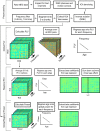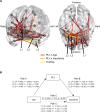Adolescent development of cortical oscillations: Power, phase, and support of cognitive maturation
- PMID: 30500809
- PMCID: PMC6291169
- DOI: 10.1371/journal.pbio.2004188
Adolescent development of cortical oscillations: Power, phase, and support of cognitive maturation
Abstract
During adolescence, the integration of specialized functional brain networks related to cognitive control continues to increase. Slow frequency oscillations (4-10 Hz) have been shown to support cognitive control processes, especially within prefrontal regions. However, it is unclear how neural oscillations contribute to functional brain network development and improvements in cognitive control during adolescence. To bridge this gap, we employed magnetoencephalography (MEG) to explore changes in oscillatory power and phase coupling across cortical networks in a sample of 68 adolescents and young adults. We found a redistribution of power from lower to higher frequencies throughout adolescence, such that delta band (1-3 Hz) power decreased, whereas beta band power (14-16 and 22-26 Hz) increased. Delta band power decreased with age most strongly in association networks within the frontal lobe and operculum. Conversely, beta band power increased throughout development, most strongly in processing networks and the posterior cingulate cortex, a hub of the default mode (DM) network. In terms of phase, theta band (5-9 Hz) phase-locking robustly decreased with development, following an anterior-to-posterior gradient, with the greatest decoupling occurring between association networks. Additionally, decreased slow frequency phase-locking between frontolimbic regions was related to decreased impulsivity with age. Thus, greater decoupling of slow frequency oscillations may afford functional networks greater flexibility during the resting state to instantiate control when required.
Conflict of interest statement
The authors have declared that no competing interests exist.
Figures







Similar articles
-
Frontal preparatory neural oscillations associated with cognitive control: A developmental study comparing young adults and adolescents.Neuroimage. 2016 Aug 1;136:139-48. doi: 10.1016/j.neuroimage.2016.05.017. Epub 2016 May 10. Neuroimage. 2016. PMID: 27173759 Free PMC article.
-
Disruption of Frontal Lobe Neural Synchrony During Cognitive Control by Alcohol Intoxication.J Vis Exp. 2019 Feb 6;(144):10.3791/58839. doi: 10.3791/58839. J Vis Exp. 2019. PMID: 30799848 Free PMC article.
-
Spontaneous cortical activity transiently organises into frequency specific phase-coupling networks.Nat Commun. 2018 Jul 30;9(1):2987. doi: 10.1038/s41467-018-05316-z. Nat Commun. 2018. PMID: 30061566 Free PMC article.
-
Functional integration across oscillation frequencies by cross-frequency phase synchronization.Eur J Neurosci. 2018 Oct;48(7):2399-2406. doi: 10.1111/ejn.13767. Epub 2017 Dec 2. Eur J Neurosci. 2018. PMID: 29094462 Review.
-
A new approach to neuroimaging with magnetoencephalography.Hum Brain Mapp. 2005 Jun;25(2):199-211. doi: 10.1002/hbm.20102. Hum Brain Mapp. 2005. PMID: 15846771 Free PMC article. Review.
Cited by
-
Electroencephalogram features support the retrogenesis hypothesis of Alzheimer's disease: Exploratory comparison of brain changes in aging and childhood.J Alzheimers Dis. 2025 Aug;106(4):1395-1414. doi: 10.1177/13872877251352119. Epub 2025 Jun 30. J Alzheimers Dis. 2025. PMID: 40586221 Free PMC article.
-
Temporal autocorrelation is predictive of age-An extensive MEG time-series analysis.Proc Natl Acad Sci U S A. 2025 Feb 25;122(8):e2411098122. doi: 10.1073/pnas.2411098122. Epub 2025 Feb 20. Proc Natl Acad Sci U S A. 2025. PMID: 39977317 Free PMC article.
-
Reaction Time Improvements by Neural Bistability.Behav Sci (Basel). 2019 Mar 18;9(3):28. doi: 10.3390/bs9030028. Behav Sci (Basel). 2019. PMID: 30889937 Free PMC article.
-
Frontoparietal network and neuropsychological measures in typically developing children.Neuropsychologia. 2021 Aug 20;159:107914. doi: 10.1016/j.neuropsychologia.2021.107914. Epub 2021 Jun 10. Neuropsychologia. 2021. PMID: 34119500 Free PMC article.
-
Developmental changes in endogenous testosterone have sexually-dimorphic effects on spontaneous cortical dynamics.Hum Brain Mapp. 2023 Dec 1;44(17):6043-6054. doi: 10.1002/hbm.26496. Epub 2023 Oct 9. Hum Brain Mapp. 2023. PMID: 37811842 Free PMC article.
References
-
- Luna B, Marek S, Larsen B, Tervo-Clemmens B, Chahal R. An integrative model of the maturation of cognitive control. Annual Review of Neuroscience. 2015;38: 151–170. 10.1146/annurev-neuro-071714-034054 - DOI - PMC - PubMed
-
- Galvan A, Hare T, Voss H, Glover G, Casey BJ. Risk-taking and the adolescent brain: who is at risk? Developmental Science. 2007;10: F8–F14. 10.1111/j.1467-7687.2006.00579.x - DOI - PubMed
-
- Ordaz SJ, Foran W, Velanova K, Luna B. Longitudinal growth curves of brain function underlying inhibitory control through adolescence. The Journal of Neuroscience. 2013;33: 18109–18124. 10.1523/JNEUROSCI.1741-13.2013 - DOI - PMC - PubMed
-
- Crone EA, Zanolie K, Van LL, Westenberg PM, Rombouts SA. Neural mechanisms supporting flexible performance adjustment during development. Cogn AffectBehavNeurosci. 2008;8: 165–177. - PubMed
-
- Hwang K, Velanova K, Luna B. Strengthening of top-down frontal cognitive control networks underlying the development of inhibitory control: A functional magnetic resonance imaging effective connectivity study. Journal of Neuroscience. 2010;30: 15535–15545. 10.1523/JNEUROSCI.2825-10.2010 - DOI - PMC - PubMed
Publication types
MeSH terms
Grants and funding
LinkOut - more resources
Full Text Sources
Medical
Miscellaneous

